Acoustic Beamforming Using a Microphone Array
This example illustrates microphone array beamforming to extract desired speech signals in an interference-dominant, noisy environment. Such operations are useful to enhance speech signal quality for perception or further processing. For example, the noisy environment can be a trading room, and the microphone array can be mounted on the monitor of a trading computer. If the trading computer must accept speech commands from a trader, the beamformer operation is crucial to enhance the received speech quality and achieve the designed speech recognition accuracy.
This example shows two types of time domain beamformers: the time delay beamformer and the Frost beamformer. It illustrates how one can use diagonal loading to improve the robustness of the Frost beamformer. You can listen to the speech signals at each processing step if your system has sound support.
Define a Uniform Linear Array
First, we define a uniform linear array (ULA) to receive the signal. The array contains 10 omnidirectional microphones and the element spacing is 5 cm.
microphone = ... phased.OmnidirectionalMicrophoneElement('FrequencyRange',[20 20e3]); Nele = 10; ula = phased.ULA(Nele,0.05,'Element',microphone); c = 340; % sound speed, in m/s
Simulate the Received Signals
Next, we simulate the multichannel signals received by the microphone array. We begin by loading two recorded speeches and one laughter recording. We also load the laughter audio segment as interference. The sampling frequency of the audio signals is 8 kHz.
Because the audio signal is usually large, it is often not practical to read the entire signal into the memory. Therefore, in this example, we will simulate and process the signal in a streaming fashion, i.e., breaking the signal into small blocks at the input, processing each block, and then assembling them at the output.
The incident direction of the first speech signal is -30 degrees in azimuth and 0 degrees in elevation. The direction of the second speech signal is -10 degrees in azimuth and 10 degrees in elevation. The interference comes from 20 degrees in azimuth and 0 degrees in elevation.
ang_dft = [-30; 0]; ang_cleanspeech = [-10; 10]; ang_laughter = [20; 0];
Now we can use a wideband collector to simulate a 3-second multichannel signal received by the array. Notice that this approach assumes that each input single-channel signal is received at the origin of the array by a single microphone.
fs = 8000; collector = phased.WidebandCollector('Sensor',ula,'PropagationSpeed',c,... 'SampleRate',fs,'NumSubbands',1000,'ModulatedInput', false); t_duration = 3; % 3 seconds t = 0:1/fs:t_duration-1/fs;
We generate a white noise signal with a power of 1e-4 watts to represent the thermal noise for each sensor. A local random number stream ensures reproducible results.
prevS = rng(2008);
noisePwr = 1e-4; % noise powerWe now start the simulation. At the output, the received signal is stored in a 10-column matrix. Each column of the matrix represents the signal collected by one microphone. Note that we are also playing back the audio using the streaming approach during the simulation.
% preallocate NSampPerFrame = 1000; NTSample = t_duration*fs; sigArray = zeros(NTSample,Nele); voice_dft = zeros(NTSample,1); voice_cleanspeech = zeros(NTSample,1); voice_laugh = zeros(NTSample,1); % set up audio device writer audioWriter = audioDeviceWriter('SampleRate',fs, ... 'SupportVariableSizeInput', true); isAudioSupported = (length(getAudioDevices(audioWriter))>1); dftFileReader = dsp.AudioFileReader('dft_voice_8kHz.wav',... 'SamplesPerFrame',NSampPerFrame); speechFileReader = dsp.AudioFileReader('cleanspeech_voice_8kHz.wav',... 'SamplesPerFrame',NSampPerFrame); laughterFileReader = dsp.AudioFileReader('laughter_8kHz.wav',... 'SamplesPerFrame',NSampPerFrame); % simulate for m = 1:NSampPerFrame:NTSample sig_idx = m:m+NSampPerFrame-1; x1 = dftFileReader(); x2 = speechFileReader(); x3 = 2*laughterFileReader(); temp = collector([x1 x2 x3],... [ang_dft ang_cleanspeech ang_laughter]) + ... sqrt(noisePwr)*randn(NSampPerFrame,Nele); if isAudioSupported play(audioWriter,0.5*temp(:,3)); end sigArray(sig_idx,:) = temp; voice_dft(sig_idx) = x1; voice_cleanspeech(sig_idx) = x2; voice_laugh(sig_idx) = x3; end
Notice that the laughter masks the speech signals, rendering them unintelligible. We can plot the signal in channel 3 as follows:
plot(t,sigArray(:,3)); xlabel('Time (sec)'); ylabel ('Amplitude (V)'); title('Signal Received at Channel 3'); ylim([-3 3]);
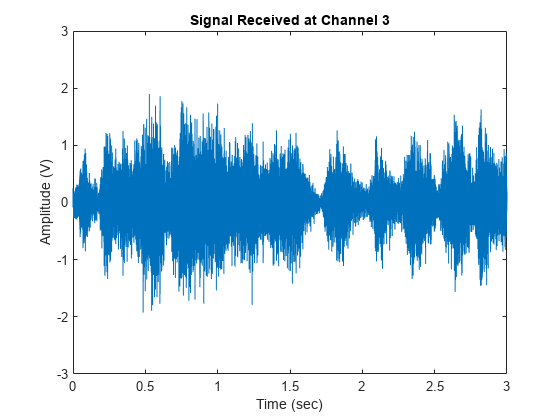
Process with a Time Delay Beamformer
The time delay beamformer compensates for the arrival time differences across the array for a signal coming from a specific direction. The time aligned multichannel signals are coherently averaged to improve the signal-to-noise ratio (SNR). Now, define a steering angle corresponding to the incident direction of the first speech signal and construct a time delay beamformer.
angSteer = ang_dft; beamformer = phased.TimeDelayBeamformer('SensorArray',ula,... 'SampleRate',fs,'Direction',angSteer,'PropagationSpeed',c)
beamformer =
phased.TimeDelayBeamformer with properties:
SensorArray: [1x1 phased.ULA]
PropagationSpeed: 340
SampleRate: 8000
DirectionSource: 'Property'
Direction: [2x1 double]
WeightsOutputPort: false
Next, we process the synthesized signal, plot and listen to the output of the conventional beamformer. Again, we play back the beamformed audio signal during the processing.
signalsource = dsp.SignalSource('Signal',sigArray,... 'SamplesPerFrame',NSampPerFrame); cbfOut = zeros(NTSample,1); for m = 1:NSampPerFrame:NTSample temp = beamformer(signalsource()); if isAudioSupported play(audioWriter,temp); end cbfOut(m:m+NSampPerFrame-1,:) = temp; end plot(t,cbfOut); xlabel('Time (Sec)'); ylabel ('Amplitude (V)'); title('Time Delay Beamformer Output'); ylim([-3 3]);
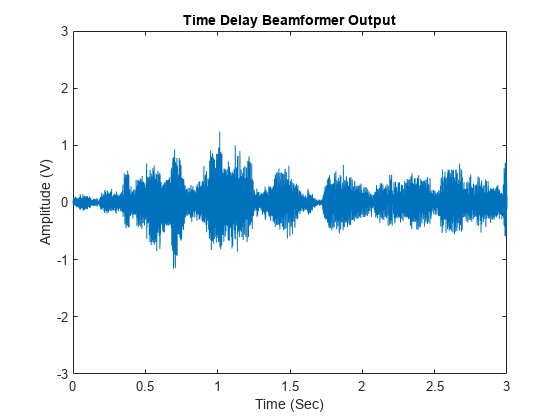
One can measure the speech enhancement by the array gain, which is the ratio of output signal-to-interference-plus-noise ratio (SINR) to input SINR.
agCbf = pow2db(mean((voice_cleanspeech+voice_laugh).^2+noisePwr)/...
mean((cbfOut - voice_dft).^2))agCbf = 9.5022
The first speech signal begins to emerge in the time delay beamformer output. We obtain an SINR improvement of 9.4 dB. However, the background laughter is still comparable to the speech. To obtain better beamformer performance, use a Frost beamformer.
Process with a Frost Beamformer
By attaching FIR filters to each sensor, the Frost beamformer has more beamforming weights to suppress the interference. It is an adaptive algorithm that places nulls at learned interference directions to better suppress the interference. In the steering direction, the Frost beamformer uses distortionless constraints to ensure desired signals are not suppressed. Let us create a Frost beamformer with a 20-tap FIR after each sensor.
frostbeamformer = ... phased.FrostBeamformer('SensorArray',ula,'SampleRate',fs,... 'PropagationSpeed',c,'FilterLength',20,'DirectionSource','Input port');
Next, process the synthesized signal using the Frost beamformer.
reset(signalsource); FrostOut = zeros(NTSample,1); for m = 1:NSampPerFrame:NTSample FrostOut(m:m+NSampPerFrame-1,:) = ... frostbeamformer(signalsource(),ang_dft); end
We can play and plot the entire audio signal once it is processed.
if isAudioSupported play(audioWriter,FrostOut); end plot(t,FrostOut); xlabel('Time (sec)'); ylabel ('Amplitude (V)'); title('Frost Beamformer Output'); ylim([-3 3]);
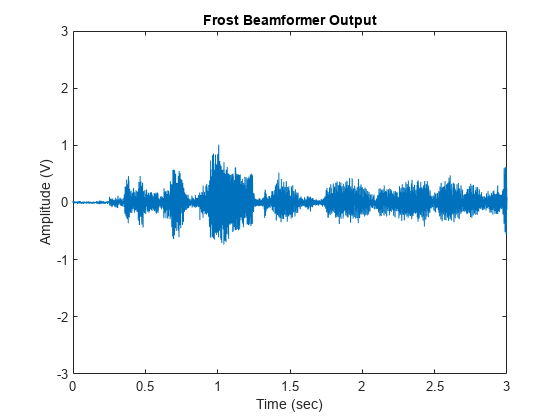
% Calculate the array gain agFrost = pow2db(mean((voice_cleanspeech+voice_laugh).^2+noisePwr)/... mean((FrostOut - voice_dft).^2))
agFrost = 14.4385
Notice that the interference is now canceled. The Frost beamformer has an array gain of 14 dB, which is 4.5 dB higher than that of the time delay beamformer. The performance improvement is impressive, but has a high computational cost. In the preceding example, an FIR filter of order 20 is used for each microphone. With all 10 sensors, one needs to invert a 200-by-200 matrix, which may be expensive in real-time processing.
Use Diagonal Loading to Improve Robustness of the Frost Beamformer
Next, we want to steer the array in the direction of the second speech signal. Suppose we do not know the exact direction of the second speech signal except a rough estimate of azimuth -5 degrees and elevation 5 degrees.
release(frostbeamformer); ang_cleanspeech_est = [-5; 5]; % Estimated steering direction reset(signalsource); FrostOut2 = zeros(NTSample,1); for m = 1:NSampPerFrame:NTSample FrostOut2(m:m+NSampPerFrame-1,:) = frostbeamformer(signalsource(),... ang_cleanspeech_est); end if isAudioSupported play(audioWriter,FrostOut2); end plot(t,FrostOut2); xlabel('Time (sec)'); ylabel ('Amplitude (V)'); title('Frost Beamformer Output'); ylim([-3 3]);
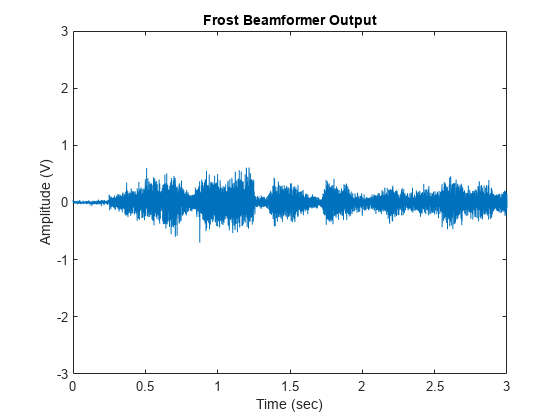
% Calculate the array gain agFrost2 = pow2db(mean((voice_dft+voice_laugh).^2+noisePwr)/... mean((FrostOut2 - voice_cleanspeech).^2))
agFrost2 = 6.1927
The speech is barely audible. Despite the 6.1 dB gain from the beamformer, performance suffers from the inaccurate steering direction. One way to improve the robustness of the Frost beamformer is to use diagonal loading. This approach adds a small quantity to the diagonal elements of the estimated covariance matrix. Here we use a diagonal value of 1e-3.
% Specify diagonal loading value release(frostbeamformer); frostbeamformer.DiagonalLoadingFactor = 1e-3; reset(signalsource); FrostOut2_dl = zeros(NTSample,1); for m = 1:NSampPerFrame:NTSample FrostOut2_dl(m:m+NSampPerFrame-1,:) = ... frostbeamformer(signalsource(),ang_cleanspeech_est); end if isAudioSupported play(audioWriter,FrostOut2_dl); end plot(t,FrostOut2_dl); xlabel('Time (sec)'); ylabel ('Amplitude (V)'); title('Frost Beamformer Output'); ylim([-3 3]);
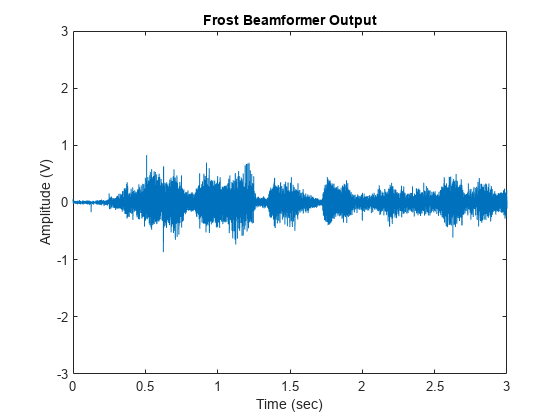
% Calculate the array gain agFrost2_dl = pow2db(mean((voice_dft+voice_laugh).^2+noisePwr)/... mean((FrostOut2_dl - voice_cleanspeech).^2))
agFrost2_dl = 6.4788
Now the output speech signal is improved and we obtain a 0.3 dB gain improvement from the diagonal loading technique.
release(frostbeamformer); release(signalsource); if isAudioSupported pause(3); % flush out AudioPlayer buffer release(audioWriter); end rng(prevS);
Summary
This example shows how to use time domain beamformers to retrieve speech signals from noisy microphone array measurements. The example also shows how to simulate an interference-dominant signal received by a microphone array. The example used both time delay and the Frost beamformers and compared their performance. The Frost beamformer has a better interference suppression capability. The example also illustrates the use of diagonal loading to improve the robustness of the Frost beamformer.
Reference
[1] O. L. Frost III, An algorithm for linear constrained adaptive array processing, Proceedings of the IEEE, Vol. 60, Number 8, Aug. 1972, pp. 925-935.
